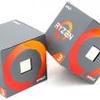Introduction
AMD Ryzen 3 1200 & 1300x
Fantastic performance for 109 and 129 USD four-core procs.
AMD is rattling all the cages in the processor industry as they offer another shift in the CPU arena. Entry level processors are going quad-core! Yes, AMD is at it again, this time with their Ryzen 3 series processors, in this review we test both their Ryzen 3 1200 and 1300X SKUs. That means you can gain tremendous performance in the lowest price bracket. Yep, mainstream performance for low-end prices! You can see and compare the Ryzen 3 processor series lining up with Intel's Core i3 series. The difference, of course, is that Intel offers the Core i3 series as a dual core part, and only recently started adding an SMT/HT version configured as 2c and 4 threads. They did that as they noticed what was coming from AMD. In an incredibly bold move AMD today launches Ryzen 3, and they all are quad core based. It is the same processor as the 8-core version, but just with four cores enabled and SMT (threading) disabled (as hey, they do not want to cannibalize their own Ryzen 5 series).
- Ryzen 3 1200 - Things get even better though, these are properly clocked products at amazing prices. The Ryzen 3 1200 offers 4 cores and threads at 109 USD. This part clocks in at a 3.1 base clock with its turbo at 3.4 GHz. It is a 65W part.
- Ryzen 3 1300X - This one will excel in everything and is called the Ryzen 3 1300X. It offers 4 cores and threads at just 129 USD. This part clocks in at a 3.4 base clock with its turbo at 3.7 GHz. It also is a 65W part.
I think the 1300X will be the success story, as it offers a bit more tweakability (clocks fine to 4 GHz in our tests) but also has an extended XFR range of 200 MHz, opposed to 50 Mhz for the Ryzen 3 1200. That means with proper cooling and conditions, the Ryzen 3 1300X can already reach 3.9 GHz. And that means a well binned proc you guys. Both processors are lined up against Intel's Core i3 7100 (dual core / 119 USD) and 7300 (dual core / 149 USD) processors.
Base specs:
- 65W TDP
- 2+2 CCX config
- 8MB L3 cache
- 512K L2 cache per core
So, under the hood is this an 8-core Ryzen processor? Yes, the processors are ALL the very same 8-core parts (physically). Yet they have been sorted (binned) and reconfigured. That quad-core in reality is the 8-core part yet set up and enabled in a 2+2 fashion, thus each out of the two 4-core clusters (CCXs) has 2 cores enabled. For the six-core parts that means per 4-core cluster (CCX) one core is disabled and that means these processors are set up in a 3+3 fashion. Other than that, again, these are physically the 8-core Summit Ridge parts. That also invokes corresponding caches, TDPs and yes, these processors get an unlocked multiplier as well. The Ryzen 3 series has a 65W TDP. Many of you have been following the news and our articles on memory latency and compatibility. Newer BIOS updates (AGESA 1006 and upwards based firmware) ensure better performance and take a notch off of memory latency. We have been testing this in-depth and are happy to report that, with the right choice in memory, the 'early' issues are a thing of the past. For some guidance in memory choices, please check this article. We have moved towards testing both Intel and Ryzen processors at 3200 MHz. This symbiosis in-between Ryzen and higher-frequency memory is a very important factor to weigh in to your purchasing decisions.
On the market you will spot Ryzen series 3, 5 and 7 processors. It’s plain and simple and, as always, that works out the best to understand product positioning compared to the Intel line-up. We’ll go into more detail on the next few pages, of course. The Ryzen series 3 processors are four core processors at incredibly sexy pricing combined with a nice IPC increase over the last generation products. Overall we have lots to talk about and to look at, let’s start up the review shall we?


